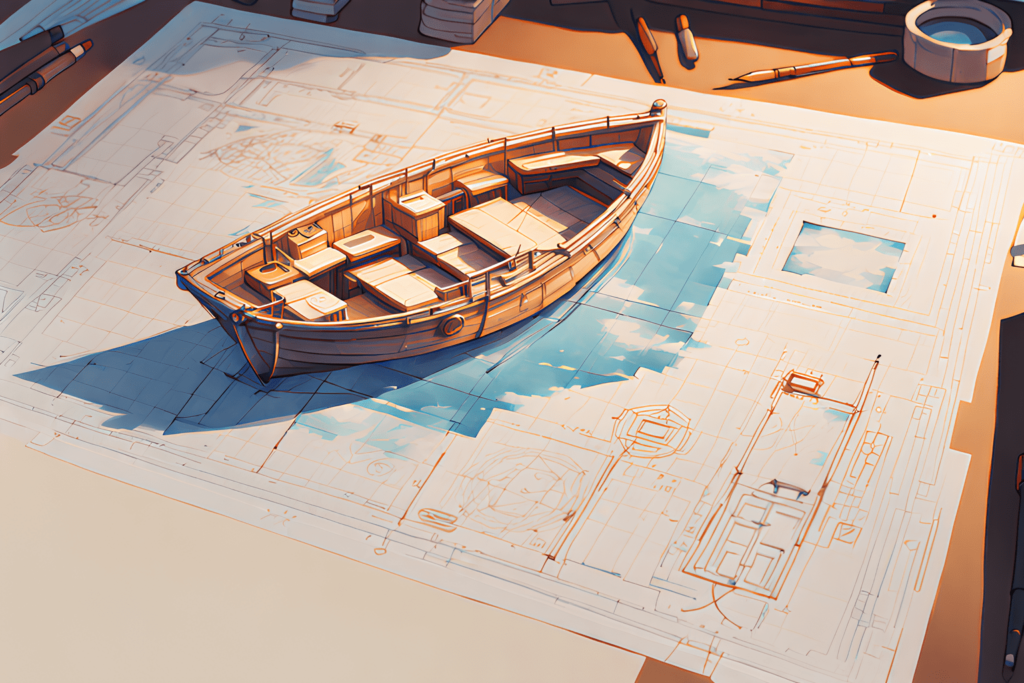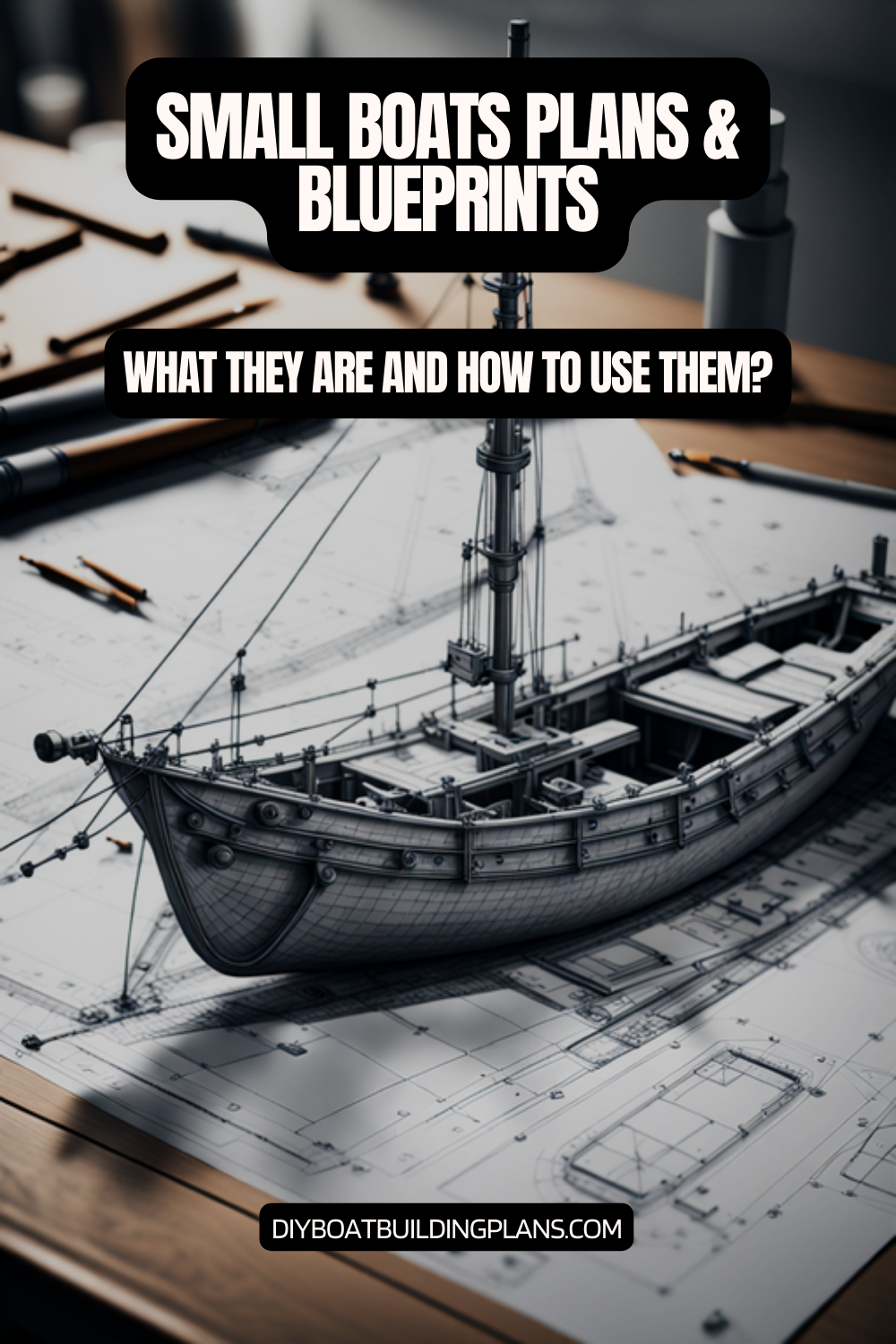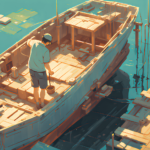Overview of Small Boat Plans & Blueprints
Small boats have long captured the imagination of adventurous souls, offering a sense of freedom, exploration, and connection with the water. Whether you’re an experienced sailor or a newcomer to the world of boating, the allure of building your own small boat can be irresistible. At the heart of this endeavor lie the small boat plans and blueprints, which serve as the roadmap to transforming your dreams into a tangible reality.
Defining small boats can be a subjective task, but for the purposes of this article, we’ll consider them to be vessels that are typically less than 30 feet in length and can be easily transported and launched by a small crew. These compact and maneuverable boats hold a special appeal, allowing for intimate encounters with the water, whether it’s a peaceful day on a lake, a thrilling ride through coastal waters, or a serene exploration of a meandering river.
The role of plans and blueprints in small boat construction cannot be overstated. These detailed technical drawings provide the essential information needed to bring your vision to life, ensuring the structural integrity, safety, and functionality of your vessel. By following these comprehensive guides, even novice boat builders can embark on the rewarding journey of creating their own custom-built small boat, tailored to their specific needs and preferences.
Key Takeaways
- Small boat plans and blueprints are essential for successful boat construction
- Detailed plans are important for ensuring accuracy and avoiding mistakes
- Choosing the right design and materials is crucial for a functional and safe boat
- Understanding and interpreting boat blueprints requires careful attention to detail
- Customizing plans to fit your specific needs can result in a truly unique and personalized boat

The Importance of Detailed Boat Plans
Constructing a small boat requires a meticulous attention to detail, and the importance of having access to detailed plans and blueprints cannot be overstated. These technical documents serve as the foundation for ensuring the structural integrity and safety of your vessel, guiding you through every step of the construction process.
Detailed boat plans are essential for maintaining the structural integrity and safety of your small boat. They provide the necessary information to calculate the appropriate materials, dimensions, and load-bearing capacities, ensuring that your vessel can withstand the rigors of the water without compromising the safety of its occupants. By following the precise specifications outlined in the plans, you can have confidence that your boat will be able to navigate the waterways with stability and reliability.
Furthermore, the detailed nature of boat plans and blueprints facilitates the construction process, serving as a comprehensive roadmap that guides you through each phase of the build. From the initial layout and framing to the installation of the hull, deck, and rigging, the plans provide clear instructions and diagrams that help you stay organized, efficient, and on track. This level of guidance is particularly valuable for first-time boat builders, who can rely on the plans to navigate the complexities of the construction process.
Customization and personalization are also key benefits of working with detailed boat plans. These technical documents often provide flexibility in design, allowing you to incorporate your own preferences and modifications to create a truly unique vessel. Whether it’s adjusting the dimensions, incorporating specialized features, or adding personal touches, the plans serve as a flexible framework that enables you to tailor the boat to your specific needs and desires. This level of customization can be a deeply rewarding aspect of the boat-building experience.
Choosing the Right Small Boat Design
Selecting the right small boat design is a crucial step in the boat-building process, as it sets the foundation for the entire project. When it comes to choosing the perfect design, several factors must be considered, including the intended use of the boat, its size, and the skill level of the builder.
The intended use of the small boat is a primary factor to consider when selecting a design. Are you planning to use the boat for recreational activities, such as fishing, sailing, or leisurely cruising? Or do you have more specialized needs, like racing or exploring remote waterways? Understanding the specific purpose of your boat will help you narrow down the design options and ensure that the final product meets your requirements.
Equally important is the size of the boat, which can vary greatly depending on the intended use and the builder’s skill level. Smaller boats, typically under 20 feet in length, may be more suitable for beginners or those with limited space for storage and transportation. Larger small boats, up to 30 feet, offer more versatility and can accommodate more passengers or gear, but may require more advanced building skills and resources.
When researching and evaluating different small boat designs, it’s essential to balance functionality, aesthetics, and personal preferences. Explore a variety of designs, from classic wooden sailboats to modern fiberglass motorboats, and consider how each option aligns with your intended use, skill level, and visual preferences. Consulting with experienced boat builders or attending boat-building workshops can also provide valuable insights and guidance in the decision-making process.
Ultimately, the right small boat design is the one that strikes a harmonious balance between your needs, abilities, and aspirations. By carefully considering these factors and thoroughly researching your options, you can make an informed decision that sets the stage for a successful and rewarding boat-building experience.
Understanding the Components of Boat Plans
Navigating the intricate world of boat plans and blueprints can be a daunting task, especially for first-time boat builders. However, by familiarizing yourself with the different components of these technical documents, you can unlock a deeper understanding of the construction process and ensure a smoother journey from design to completion.
At the heart of any boat plan lies a series of detailed technical drawings, each offering a unique perspective on the vessel’s structure and components. These may include plan views, which provide a top-down look at the boat’s layout; profile views, which showcase the side profile; and various cross-sectional views, which reveal the internal construction details. Mastering the interpretation of these different views is crucial for visualizing the three-dimensional form of the boat and translating the information into practical steps.
Accompanying the technical drawings are a wealth of specifications and measurements, detailing everything from the dimensions of the hull and deck to the size and placement of individual components. Understanding the significance of these numerical values and their relationship to the overall design is essential for ensuring the structural integrity and proper fit of the boat’s parts.
Familiarizing yourself with common boat-building terminology is another important aspect of interpreting boat plans. Terms like “chine,” “transom,” and “sheer” may seem foreign at first, but becoming acquainted with these specialized words and their meanings will help you navigate the technical language and better comprehend the construction process.
Ultimately, the ability to accurately read and interpret boat plans is a crucial skill for any aspiring small boat builder. By investing time in understanding the different components and their significance, you can develop a comprehensive understanding of the boat’s design, which will serve as a solid foundation for the construction phase and help you overcome any challenges that may arise along the way.
Selecting the Appropriate Materials for Your Boat
| Plan Name | Price | Length | Beam | Weight |
|---|---|---|---|---|
| Classic Wooden Boat Plans | 29.99 | 12 ft | 4 ft | 200 lbs |
| Aluminum Jon Boat Plans | 19.99 | 14 ft | 5 ft | 150 lbs |
| Stitch and Glue Kayak Plans | 24.99 | 10 ft | 2.5 ft | 50 lbs |
| Flat Bottom Boat Plans | 34.99 | 16 ft | 6 ft | 300 lbs |
Choosing the right materials for your small boat construction is a crucial step that can have a significant impact on the overall performance, durability, and aesthetics of the final product. As you delve into the world of boat plans and blueprints, it’s essential to carefully consider the various material options and how they align with the specific requirements of your chosen design.
When it comes to small boat construction, the most common materials used include wood, fiberglass, and aluminum. Each of these materials has its own unique set of characteristics, strengths, and weaknesses, and the selection process should be guided by the intended use of the boat, the desired level of performance, and your personal preferences.
Wooden boats, for instance, offer a classic and timeless appeal, with the ability to be customized and personalized to a high degree. However, they also require more maintenance and can be susceptible to environmental factors like moisture and weathering. Fiberglass, on the other hand, is known for its durability, low maintenance, and ability to withstand the rigors of the water, making it a popular choice for recreational and performance-oriented small boats. Aluminum, meanwhile, is prized for its strength, corrosion resistance, and lightweight properties, making it a suitable option for boats that need to be easily transported or launched.
Beyond the inherent properties of the materials, it’s also crucial to consider the availability, cost, and ease of working with them. Some materials may be more readily accessible in your local area, while others may require specialized suppliers or additional processing. Additionally, the budget you have allocated for your small boat project can play a significant role in the material selection process, as certain options may be more cost-effective than others.
By carefully weighing the various factors and aligning the material choices with the specific requirements of your boat design, you can ensure that your small boat not only meets your functional needs but also reflects your personal style and preferences. Consulting with experienced boat builders or material suppliers can also provide valuable insights and guidance in the decision-making process.
Step-by-Step Guide to Reading and Interpreting Boat Blueprints
Deciphering the intricate details of boat blueprints can be a daunting task, but with a systematic approach and a keen eye for detail, you can unlock the wealth of information they contain. As you embark on your small boat-building journey, mastering the art of reading and interpreting these technical documents will be a crucial skill that will guide you through every step of the construction process.
The first step in understanding boat blueprints is to familiarize yourself with the different views and perspectives presented. These may include plan views, which provide a top-down look at the boat’s layout; profile views, showcasing the side profile; and various cross-sectional views, revealing the internal construction details. By studying these different perspectives, you can develop a comprehensive understanding of the boat’s three-dimensional form and how the various components fit together.
Next, it’s essential to closely examine the technical specifications and measurements provided in the blueprints. These numerical values hold the key to ensuring the structural integrity and proper fit of the boat’s parts. From the dimensions of the hull and deck to the size and placement of individual components, every detail must be meticulously recorded and translated into practical steps during the construction process.
As you delve deeper into the blueprints, familiarize yourself with the common boat-building terminology used. Terms like “chine,” “transom,” and “sheer” may seem foreign at first, but understanding their meanings and how they relate to the overall design will greatly enhance your ability to interpret the technical information.
With a solid grasp of the different views, measurements, and terminology, you can then begin to develop a comprehensive construction plan. By carefully translating the blueprint information into a step-by-step guide, you can ensure that every aspect of the build is executed with precision and attention to detail, minimizing the risk of errors or unexpected challenges.
Mastering the art of reading and interpreting boat blueprints is a crucial skill that will serve you well throughout the small boat-building process. By approaching this task with patience, diligence, and a keen eye for detail, you can unlock the full potential of your chosen design and bring your dream boat to life.
Customizing Small Boat Plans to Fit Your Needs
The beauty of building your own small boat lies in the ability to customize the design to suit your unique needs and preferences. While the boat plans and blueprints provide a solid foundation, the true joy of the process often comes from incorporating your personal touch and making the vessel your own.
One of the primary ways to customize small boat plans is by modifying the design to accommodate your specific requirements. This could involve adjusting the dimensions to better fit your available space or desired carrying capacity, or incorporating additional features or accessories that enhance the functionality of the boat. Whether it’s adding specialized storage compartments, upgrading the propulsion system, or incorporating unique aesthetic elements, the plans serve as a flexible framework that allows you to tailor the boat to your liking.
Addressing site-specific constraints or limitations is another important aspect of customizing small boat plans. If you have limited access to a launch site, for example, you may need to adjust the boat’s size or weight to ensure it can be easily transported and launched. Similarly, if you plan to use the boat in a particular body of water with unique environmental conditions, you may need to modify the design to optimize its performance and safety.
Collaborating with experienced boat designers or builders can be an invaluable resource when it comes to customizing small boat plans. These professionals can provide guidance on the feasibility of your proposed modifications, offer suggestions for enhancing the design, and help you navigate any technical or structural challenges that may arise. By tapping into their expertise, you can ensure that your customizations not only meet your personal preferences but also maintain the integrity and functionality of the boat.
Ultimately, the ability to customize small boat plans is what makes the building process so rewarding and fulfilling. By infusing your own creativity and personal touch into the design, you can create a truly unique vessel that reflects your individual style and meets your specific needs. Whether it’s a subtle modification or a complete redesign, the flexibility of the plans allows you to bring your vision to life and take pride in the one-of-a-kind small boat you’ve created.
Tips for Successful Small Boat Construction
Building your own small boat is a deeply rewarding and challenging endeavor, one that requires a combination of technical skills, attention to detail, and perseverance. As you embark on this journey, guided by the boat plans and blueprints, it’s essential to equip yourself with the right tools and strategies to ensure a successful and satisfying outcome.
Establishing a well-organized workspace and work schedule is a crucial first step. Designate a dedicated area for your boat-building project, ensuring that it is spacious enough to accommodate the various stages of construction and provides ample lighting and ventilation. Additionally, develop a detailed work schedule that takes into account the time required for each phase of the build, allowing you to stay on track and maintain momentum throughout the process.
Developing essential boat-building skills and techniques is another key factor in achieving success. Whether it’s mastering the art of woodworking, learning the intricacies of fiberglass layup, or honing your welding abilities, investing time and effort into building your practical skills will pay dividends as you navigate the construction process. Consider seeking out workshops, tutorials, or mentorship opportunities to enhance your knowledge and confidence.
Troubleshooting common challenges and finding solutions is an inevitable part of any boat-building endeavor. From unexpected material issues to structural problems, be prepared to encounter obstacles along the way. By approaching these challenges with a problem-solving mindset, consulting the boat plans and blueprints, and seeking guidance from experienced builders, you can overcome these hurdles and maintain the integrity of your project.
Throughout the construction process, it’s crucial to maintain a meticulous attention to detail and quality. Every measurement, every joint, and every component must be carefully executed to ensure the structural integrity and functionality of your small boat. Regularly refer back to the plans, double-check your work, and be willing to take the time necessary to get each step right, even if it means slowing down the overall pace of the build.
By embracing these tips and strategies, you can navigate the small boat construction process with confidence and a sense of accomplishment. The journey may be challenging, but the reward of seeing your dream boat come to life, and the pride of having built it with your own hands, will make it all worthwhile.
The Benefits of Building Your Own Small Boat
The decision to build your own small boat is one that can be deeply rewarding, both in terms of personal satisfaction and practical benefits. As you embark on this journey, guided by the detailed plans and blueprints, you’ll unlock a world of opportunities that extend far beyond the physical construction of the vessel.
One of the most profound rewards of building your own small boat is the sense of accomplishment and personal satisfaction that comes with it. Watching your vision take shape, overcoming challenges, and ultimately launching a boat that you’ve created with your own hands is a truly empowering experience. This sense of achievement can instill a newfound confidence and appreciation for the art of boat building, inspiring you to continue exploring and expanding your skills.
In addition to the personal fulfillment, building your own small boat can also be a cost-effective alternative to purchasing a pre-built vessel. By sourcing materials and components directly, and leveraging your own labor, you can often create a boat that is tailored to your needs and preferences at a fraction of the cost of a commercially available model. This financial advantage can open up new opportunities for exploration, adventure, and recreational activities on the water.
Beyond the practical and financial benefits, the process of building your own small boat can foster a deeper appreciation for the art of boat building and the rich history of watercraft design. As you delve into the technical details of the plans and blueprints, you’ll gain a newfound understanding and respect for the craftsmanship and engineering that goes into creating these vessels. This knowledge can enrich your overall boating experience and inspire you to continue learning and exploring the world of small boat design and construction.
Ultimately, the decision to build your own small boat is a testament to your adventurous spirit, your desire for personalization, and your willingness to take on a rewarding challenge. By embracing the detailed plans and blueprints as your guide, you can transform your dreams into a tangible reality, creating a unique and customized vessel that will serve as a source of joy, exploration, and lasting memories for years to come.
Download over 500 Boat Plans. Click on the link below.
-->Click Here<--

Conclusion – Small Boat Plans & Blueprints
In conclusion, small boat plans and blueprints are invaluable resources for anyone interested in building their own small boat. They provide a clear and structured path to follow, ensuring accuracy, safety, and efficiency throughout the construction process. By choosing the right plans, following instructions carefully, and paying attention to detail, you can create a small boat that meets your needs and preferences.
Remember that building a small boat can be a challenging yet rewarding endeavor, offering opportunities for creativity and skill development. Whether you’re a DIY enthusiast or a professional boat builder, the journey of bringing your small boat to life is a testament to your dedication and passion for the craft. Embrace the process, seek assistance when necessary, and enjoy the satisfaction of cruising the water in a vessel you’ve built with your own hands. Happy boat building!
FAQs – Small Boat Plans & Blueprints
What are small boat plans and blueprints?
Small boat plans and blueprints are detailed instructions and diagrams that guide boat builders in constructing small boats. These plans typically include information on the materials needed, measurements, and step-by-step instructions for building the boat.
What types of small boats can be built using plans and blueprints?
There are many types of small boats that can be built using plans and blueprints, including rowboats, sailboats, canoes, kayaks, and dinghies. The specific plans and blueprints needed will depend on the type of boat being built.
Where can I find small boat plans and blueprints?
Small boat plans and blueprints can be found online, in boating magazines, and at boating supply stores. There are also many websites that specialize in selling boat plans and blueprints.
Do I need any special skills to build a small boat using plans and blueprints?
While some experience with woodworking and boat building can be helpful, many small boat plans and blueprints are designed for beginners. With careful attention to detail and following the instructions closely, anyone can build a small boat using plans and blueprints.
What materials are needed to build a small boat using plans and blueprints?
The materials needed to build a small boat will depend on the specific plans and blueprints being used. However, common materials include wood, fiberglass, epoxy, and marine-grade hardware. It is important to use high-quality materials to ensure the boat is safe and durable.
How long does it take to build a small boat using plans and blueprints?
The time it takes to build a small boat using plans and blueprints will depend on the size and complexity of the boat, as well as the builder’s experience and skill level. Some small boats can be built in a few days, while others may take several weeks or even months to complete.



